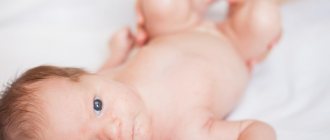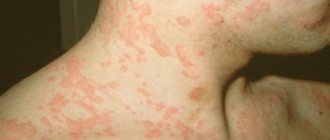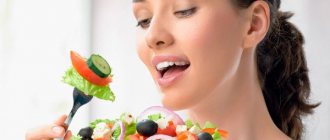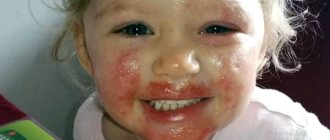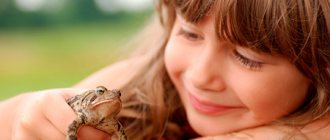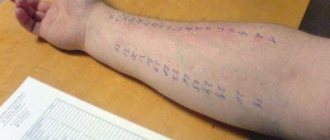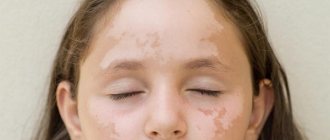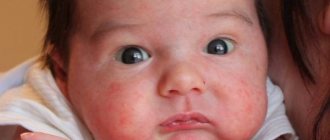Goose bumps in a child is a phenomenon that almost all parents have encountered at least once. Caring mothers and fathers cannot help but pay attention to this change in the condition of their baby’s skin. Having noticed goose bumps on a child, some parents experience great concern, while others believe that such a rash does not pose a danger and attribute everything to the physiological characteristics of the body. What exactly is this problem?
Goose bumps in a child (popularly this phenomenon is often called goosebumps) are small bumps the color of the patient’s skin that appear on the arms, especially on the elbows and shoulders, buttocks, and thighs. In some cases, goose bumps can even be found under the lower eyelids. In medicine, this phenomenon is called follicular hyperkeratosis. Typically, such skin changes are short-term and manifest themselves as a protective function of the body. However, when goose bumps persist for a long time, it may indicate the presence of serious diseases. Goose bumps on the child’s legs, abdomen and back indicate serious problems with the baby’s health.
Causes of goose bumps
In order to understand how to deal with this problem, you must first find the cause of its occurrence. Goose bumps can be the result of various factors, the most common of which are the following:
- Cold. Often goose bumps are the body’s protective reaction to cold.
- High body temperature. If goosebumps appear, it is recommended to measure the child’s temperature, since such a sign often indicates that the child has a fever.
- Emotional reaction. Goose bumps can appear as a result of experiencing strong emotions - satisfaction, fear, excitement. It can also occur when listening to music. All this can cause contraction of the muscles of the hair follicles, resulting in increased skin pattern.
- Lack of vitamins A, C and E in the body. It is these vitamins that have a great impact on the condition of the skin.
- Poor nutrition.
- Impaired metabolism.
- Too dry skin - often in this case, the skin pores become clogged, which leads to the appearance of follicular hyperkeratosis.
- Insufficient personal hygiene. The top layer of skin contains keratin, which easily comes off with regular hygiene procedures. If this is not the case, the follicles gradually become clogged and a goosebumps effect occurs.
- Hereditary predisposition. The most rare cause of goose bumps. It is known that when heredity is the culprit, it can be very difficult to cope with the problem. Usually in such cases only visible skin imperfections are reduced through special procedures.
- Diseases of the gastrointestinal tract, gall bladder or liver, which significantly reduce immunity.
- Hormonal disturbances and changes are most common during puberty.
- The action of external irritants, for example, the use of aggressive detergents or the child’s constant wearing of clothes made of synthetic fabrics.
- Allergy - a similar reaction of the body can be observed upon contact with food and household allergens.
- If a body condition such as goose bumps continues for quite a long time or appears too often, it is recommended to undergo examination by specialists.
Possible reasons
If goose bumps appear from fright or hypothermia, the symptom is temporary and passes quickly. In this case, there is nothing to worry about. However, there are also special pathological reasons.
Factors that can cause goose bumps:
- Pathologies of the endocrine system.
- Deficiency of vitamins B, A, E and C.
- Features of metabolism.
- Genetic predisposition.
The symptom also appears when the rules of hygiene and skin care are systematically violated.
Diagnostics
If you suspect that goose bumps are a symptom of a disease or other serious problem, you should not put off going to the doctor or try to take any independent action.
The diagnosis of follicular hyperkeratosis is always made by a dermatologist, however, to identify the causes and prescribe the correct treatment, it will be necessary to consult with specialists such as a pediatrician, endocrinologist and gastroenterologist. In many cases, several laboratory tests are also performed.
What to do if your baby has chills?
What to do if your child is shivering? This question worries all parents. Below is a list of basic guidelines to follow if your child has feverish chills3.
- Provide bed rest
Often a child's chills and fever are accompanied by weakness. The little patient in this situation needs rest. Put the child to bed and eliminate intellectual and physical stress.
- Give warm drinks
A warm, non-scalding drink will help the child replenish the body’s increased need for fluid in this state, as well as keep warm. You can make lingonberry juice, tea with lemon or any berry compote. It is advisable to offer the drink in small portions as often as possible (every 10 minutes, a few tablespoons). Read more in the material “What to drink when you have a cold?”
- Call a doctor
If a child suffers from chills, but there are no signs of a cold, then this may indicate overwork, nervous strain, and even a malfunction of the thyroid gland. In these cases, it is recommended to consult a specialist.
Be sure to call a pediatrician for the following conditions:
- high temperature (38.5–39 °C);
- fever accompanied by chattering teeth;
- sudden and severe deterioration in health;
- lethargy;
- child's capriciousness 3.
Up to contents
Treatment used
Many parents, knowing that goose bumps in children often occur due to a lack of vitamins, buy a vitamin complex at the pharmacy. However, in many cases this does not bring results, since it is impossible to determine without special tests what vitamins a child needs and in what quantities they should be taken. In addition, the problem may turn out to be completely different.
Treatment for goose bumps is to eliminate the cause that led to its appearance. However, there are a number of recommendations that will be helpful regardless of the reason.
First of all, you need to ensure proper care of your baby's skin. Care must be taken to maintain hygiene. All shampoos, gels, and soaps used to wash a child must be specially designed for children. Adult hygiene products are not as soft and gentle as children's ones, and they also contain many more chemicals, which can seriously harm the baby. You should not allow your child’s skin to dry out; this may require special scrubs, creams, oils - it is advisable to consult a dermatologist before using them. You also need to maintain the required air humidity in the room.
It is very important to provide your baby with proper nutrition. It is desirable that the diet does not contain harmful foods or they are present in minimal quantities. It is recommended that the diet include kiwi, strawberries, blueberries, carrots and dairy products. Of course, before changing a child’s diet, it is necessary to determine whether he is allergic to any foods.
It will be useful to undergo a massage course, which helps improve blood flow. To do this, you can make an appointment with a specialist or perform a massage at home using a special mitten. With this mitten you need to intensively rub the problem areas of your baby’s skin. It is known that increased blood flow makes goose bumps less noticeable.
In the absence of contraindications, it will be useful for a child to visit a sauna or bathhouse. Under the influence of high temperature and humidity, the skin will become softer, and minor defects will disappear on their own.
When going for a walk, your baby should always be dressed according to the weather: clothes should be selected so that the child does not feel too hot or cold in them. In summer, when the sun is actively shining, the child’s skin should be lubricated with a special protective cream or lotion.
Symptoms and causes of chills in a child
Doctors call chills a condition that occurs as a result of a sharp spasm of the peripheral blood vessels of the skin without an increase in blood pressure. In this case, the baby may complain of several unpleasant symptoms. Let us highlight the main signs of chills in children:
- trembling throughout the body - this is due to frequent reflex muscle contractions;
- feeling of cold - the child is freezing, even if the air temperature is above 20°C and the baby is warmly dressed;
- the appearance of “goose bumps” - small pimples are formed on the skin due to the contraction of smooth muscles around the hair follicles1.
If a child has severe chills and at the same time a nagging headache, fever, “aches” throughout the body, then this may be a sign of intoxication due to a cold, ARVI or other disease1.
Up to contents
What should you not do if your child has chills?
Carry out warming procedures
If a child with a fever has chills, inhalations and hot compresses should not be used. Warming procedures can lead to a sharp increase in body temperature and, as a result, heat stroke.
Trying to bring down the temperature using physical methods3
If you have a chill, do not use water, alcohol or vinegar wipes. A cool bath or enema with cold water to reduce fever is also contraindicated: they can only aggravate the patient's condition. In this case, the spasm of peripheral vessels will intensify, and the temperature of the internal organs, on the contrary, may increase. For fever and chills, your child can be given an antipyretic drug recommended by the doctor3.
Up to contents
Symptoms
The first symptom of goose bumps is dryness. The manifestation is often symmetrical - if there are lesions on one arm in a certain area, the second arm will be affected similarly.
Often the hair follicles become inflamed and in addition to “pimples”, pimples also appear. The disease is cosmetic in nature and does not affect general well-being.
But over time, without proper treatment, the lesions can grow, the skin becomes rougher and denser, and hard, inflamed nodules with broken hairs or the so-called “thorn” appear. Slight itching may occur.
What to do
It is important to know how to get rid of goose bumps quickly and effectively.
For this purpose, complex methods are used.
Peeling
A very effective method for getting rid of pimples on a child’s skin is regular exfoliation. Even if the goal is achieved, the goosebumps on the skin have disappeared, such procedures should become habitual, this is a good prevention of the recurrence of the problem.
Such manipulations should be performed at least three times a week. For this procedure, you can use crushed sea salt. Mix two tablespoons of sea salt with olive, almond, peach or flaxseed oil.
It is best to perform the procedure after the child has taken a bath and steamed the body a little. Using a massage glove or washcloth, apply a small amount of the mixture to the skin and rub for several minutes until slightly reddened. After this, rinse with warm water and apply moisturizing baby cream.
Bathroom
An effective method to eliminate pimples on the skin of the hands is to take a warm bath with the addition of a herbal decoction or other remedies.
Oatmeal bath
- Pour 10 cups of oatmeal into hot water.
- When the water has cooled a little, bathe the child in it.
Bath with pine needles
- Add pine extract and a spoonful of corn or potato starch to hot water.
- The duration of the procedure for a child is 15 minutes.
- Then you need to lubricate the skin with moisturizing baby cream.
Wraps
In order to provide the skin with intensive nutrition, a wrapping procedure is used using the following components:
- seaweed, kelp;
- chocolate;
- cranberry;
- honey;
- cabbage.
You can make a wrap for a child yourself at home. To do this, it is recommended to purchase dry seaweed at the pharmacy or use other means available for each.
Wrapping is easy:
- Dilute liquid honey a little with water and add a teaspoon of gelatin, wait until the gelatin swells, apply the mixture to the desired area, and wrap with cling film on top. After half an hour, wash off.
- Pour boiling water over the required amount of dry seaweed. Wait until it cools down a little. Next, strain the pulp, drain the liquid, and apply the thick mass to the area with pimples. Wrap the top with cling film. After half an hour, wash off.
- Melt a small amount of dark chocolate in a water bath or in the microwave. Apply with a brush to the desired areas of the skin, wrap on top with cling film or a plastic bag. Wait half an hour and wash off.
- Grind in a meat grinder or chop a small amount of cabbage using a blender. Apply the mixture to the skin, wrap with film. After 20 minutes, wash off.
- Chop the cranberries. Apply to skin, wrap with film. After 10 minutes, rinse with warm water and apply moisturizer or lotion.
The listed products can only be used if there is no allergic reaction to them. After the wrapping procedure, it is imperative to moisturize the skin with baby cream, a nourishing natural lotion. For a child, it is imperative to use hypoallergenic cosmetics.
Nutrition
In parallel with cosmetic procedures, you need to remember that only proper nutrition will ensure the normal functioning of internal organs and improve the condition of the skin.
Here's how to get rid of goose bumps with proper nutrition:
- Include as many fresh fruits and vegetables and herbs in your daily menu. Vitamins such as A, B, D, E are present in large quantities in plums, spinach, sweet peppers, peas, beans, and tomatoes.
- It is better to choose low-fat varieties of meat and fish.
- Be sure to include dairy products in your diet - milk, sour cream, kefir, cottage cheese.
